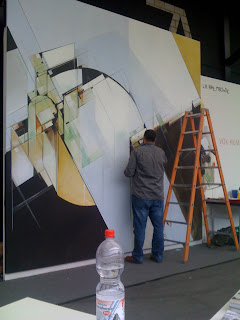Organized by L.A. Art Machine (an online publication and arts organization) in collaboration with the Rivera and Rivera gallery (downtown Los Angeles), VOX HUMANA was the name of the project through which the live painting by legendary Los Angeles street artists was taking place in Basel. The core artists in this project were MEARONE, Kofie, Retna, and El Mac. Amanda Coulson, the director of VOLTA, organized to showcase VOX HUMANA after Bryson Strauss (director of LA Art Machine) proposed the idea of bringing these artists out to Switzerland and having them paint live at the entrance of the VOLTA show. For those who have not yet attended Art Basel, this colossal art-fair is also made up of several satellite exhibitions of which VOLTA is one. VOLTA was conceived to bridge a gap between Basel's pre-existing fair by showcasing contemporary art galleries whose artists represent new and relevant positions for curators and collectors. I arrived at night and was picked up by Bryson Strauss and Retna, and we immediately headed off to the industrial area outside of the city center that housed the VOLTA 6 exhibition.
Three 12 foot by 12 foot canvases on a raised landing greeted the visitors before they entered the exhibition's interior warehouse space. I asked Carlos Rivera owner/director of Rivera and Rivera gallery his thoughts on how this project contributed to the recognition of urban/street art within the gallery/collector world.
Carlos Rivera:
To show these street artists alongside of the most prestigious art fair in the world is an affirmation of their merit as some of the most talented and respected artists today. Their international visibility, especially among art collectors is important in achieving this cognizance.
Three 12 foot by 12 foot canvases on a raised landing greeted the visitors before they entered the exhibition's interior warehouse space. I asked Carlos Rivera owner/director of Rivera and Rivera gallery his thoughts on how this project contributed to the recognition of urban/street art within the gallery/collector world.
Carlos Rivera:
To show these street artists alongside of the most prestigious art fair in the world is an affirmation of their merit as some of the most talented and respected artists today. Their international visibility, especially among art collectors is important in achieving this cognizance.
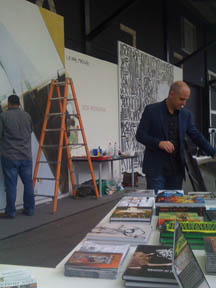 (Setup: Kofie painting right, Bryson Strauss left)
(Setup: Kofie painting right, Bryson Strauss left)MEARONE had spread his paints out on the floor in front of his canvas and had already laid in the background cityscape of LA in browns, mahoganies and ambers, Kofie was at work articulating abstract patterns & geometrical lines reminiscent of Modern Art masters, and El Mac was laying down a white base over Retna's signature calligraphy that was the first layer of their collaborative work. VOX HUMANA had a live web feed that transmitted the evolution of the project to those who chose to watch virally instead of fly to Switzerland - a decent (and cheaper) option. But in my experience nothing could match or mimic the real-deal, flesh and paint, stop-pause- and attacking that I witnessed transpire on those canvases over the course of four days. I asked Carlos Rivera why it was important for him and LA Art Machine to show live painting in lieu of smaller and more attainable work that could be easily purchased by collectors.
Carlos Rivera: Bringing the live art to the fair emphasizes the difference from traditional art where the viewer is wholly removed from the piece's creation. The metaphor of interaction is an important part of understanding the significance of street art.The form/technique/style of urban art (call it what you will) is driven and develops from a relationship with urgency in time. Or to be more precise, pressure, as artists are alert and on the lookout to finish their work on spaces that are not always legally sanctioned. Walls, buildings, trains, subways, buses, etc of the cityscape become the canvas for painting, and influence the line, style and signature of each artist. Painting on sites that are hard to get to and/or dangerous (train tunnels, tall billboards) and respecting the work already laid down by others are all part of the language/culture of this medium. The nature of its impermanence reminds me of the ethos of Fluxus work: John Cage's maxim 'life is art' and the beautiful interplay between time, transition and decay that lives outside of the confines of museum preservation. Street art is a culture and an artform that is global, and like it or not, is quickly gaining props as a reputable form of expression in galleries and the lot. In this months ArtForum interview with LA's new MOCA director Jeffrey Dietch, one of his tactics to bring a fresh audience into the museum is to launch an upcoming exhibition of LA Street Artists work. Is urban art still a relevant term and a style that can describe work that is being created on a canvas? It is in my opinion if the artist has developed out of that landscape. The work that was being created by each of the VOX HUMANA artists, the very essence of what was unfolding out on the landing of the Volta 6 exhibition, was exposing to the onlookers the technique, dialogue, history, transcription and expression of this genre in its most exquisite form.
I asked both Bryson Strauss and Carlos Rivera of Rivera and Rivera gallery why they thought work that is made on canvas and hung/purchased through a gallery could still be considered 'street art'.
Bryson Strauss:
I think that street art refers to an experience of art making and art learning. And, in fact, street art parallels many forms of creativity in this way. In essence, it is a vernacular art form that is part of an oral tradition passed on through informal master-apprenticeships rather than through formalized or institutional teaching. Knowledge and techniques are passed on from one person to another, very much the way early blues music, or folk music, or hip hop, or story telling, or good southern cooking was learned and passed on to new generations by emulation and word of mouth. These art forms are the creative products of a community and therefore they reflect the personality of that community. So, just as good soul food doesn't cease to be soul food when it's served in a restaurant, street art doesn't cease to be street art when it's displayed in a gallery or museum.
Carlos Rivera:
These artists started on the street but their medium doesn't change their art. Street art is a genre like
Pop Art or Realism; its classification is not a designation of location.
The backdrop of Basel set a beautiful stage for the event. Saddled on either side of the Rhine, this city has an impressive mix of contemporary architecture juxtaposed alongside red sandstone Romanesque/early Gothic buildings. Buildings such as the Beyeler Foundation by Renzo Piano, the Vitra Complex with buildings designed by the likes of Frank Gehry, and Zaha Hadid, & Mario Botta who designed the Jean Tinguely Museum (Tinguely is from Basel) to illustrate the different ambience from the Art Basel held in Miami Florida in December. My first night in the city, our host Gioacchino Frantese brought us into an alley adorned with tagging, murals and graffiti, taking pleasure in showing our artists some urban expression in Basel's streets. As we moved deeper into the cobblestone network of Basel's center, El Mac, Kofie and MearOne did not lose a beat in placing a bit of LA into the collage of local markings, adding their signatures to those of the locals. And finally, our destination - a tucked away Turkish restaurant that served the best food of its kind that I have had to date. We eventually retired to our accommodations in the Black Forest (gotta love that).

Bryson Strauss:
When you take something that happens in one environment and you place it into another environment it often becomes more interesting. Even though there has been a lot of hype around some street artists such as Banksy and Shepard Fairey, for the most part, street art is foreign to the art world. And in many senses, that is because is it a vernacular art form. It does not evolve from any accepted institutions or cannons of thought or mainstream art traditions. So in many ways, it's disruptive and challenging to the established structures of the art world. For me, that is seductive. It's also fresh and it's a different visual language. I think the next decade in art will be driven by what happens with street and its diaspora.Like bees to a honeycomb, the representation of street art at Art Basel drew artists, galleries and fans to the landing of Volta 6. Joshua Liner, from the Joshua Liner gallery in NYC, Write on Africa's director Ricky Lee Gordon from South Africa (creative activist), Willem Kerseboom of Willem Kerseboom gallery in Amsterdam who was represented at SCOPE, (the other satellite exhibition in Basel), globally exhibited street artist Faith47 from Cape Town, artist Chris Mendoza from the Barnstormers collective out of Brooklyn NY, acclaimed european graffiti artist SMASH 137, Italian street artist Marco Grassi aka PHO, among many others showed up to hang out, introduce themselves and check out the live painting at various moments throughout the festival. Rare books & DVDs as well as prints from other artists such as Saberone, The Date Farmers, Duster, Ernesto, Duardo, Veca, etc.. displayed at the information table triggered discussions about the subject of street art, brought up stories within the community of participants and informed visitors about its culture.
Over the next three days I made sure to use the shuttle service at VOLTA to transport me back and forth to Art Basel, which was found in the city center on the opposite side of the Rhine. From this point I walked in town to the additional exhibitions, SCOPE, the young art fair- LISTE, the local Kunstmuseum to see the Gabriel Orozco show and the Museum Fur Gegenwartskunst to see the Rodney Graham show as well as (of course) Art Basel & Art Unlimited (the installation/video art/ large sculpture component of Art Basel). Each day I returned to see the work developing and continued to participate at the booth, sharing my photos with the artists who were diligently enraptured with their canvases.
Even though all four of the painters work under the genre as "street artists", their individual styles, materials, concepts and application were all very diverse. I asked Bryson why he selected these particular four artists to work together.
Bryson Strauss:
First off, I wanted to do a Los Angeles based program because LA artists have a unique visual language. Secondly, with this selection of artists I am demonstrating the incredible range of artistic expression with the realm of street art. All of these guys are radically different in their imagery and yet none of them are stereotypically "graffiti." They are all quite visionary and unique, each one. Plus, they have serious chops with more than two decades of experience throwing up pieces. You can trust them all to pull off something awesome under pressure in an environment like Basel. That's not an easy task for even the most seasoned artists.Over the four days I observed how Kofie's architectural lines and geometrical palette were continuously layered in an organized, yet organic way that was not preconceived. The complexity of his work at Volta 6 unfolded over time as he manipulated the emerging patterns to create depth and perspective, by standing back, reviewing the work, and then delving in. He manipulated and allowed the paint to drip and fall, and then redrafted the color with precision using rulers, small brushes, and found stencils.
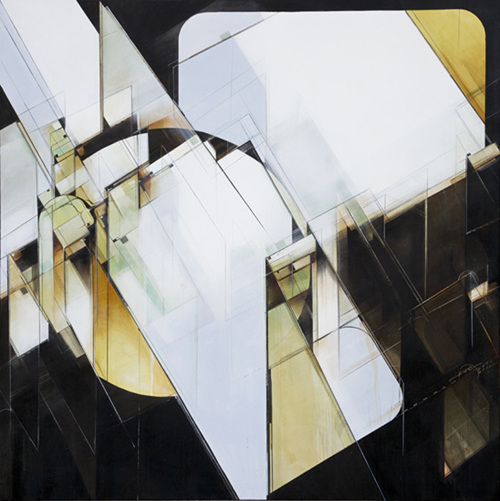
MEARONE worked off a stretch and internal vision of a concept/dreamscape. Energetic and vibrant, he danced back and forth from mixing paint to placing it on his canvas, scraping, and brushing his forms and landscape into life. Throughout the process at Volta he placed inspirational statements within the work, and his signature Phoenix rose overtop of the celestial figures on the third day which stood over of humanity, splayed on the ground.
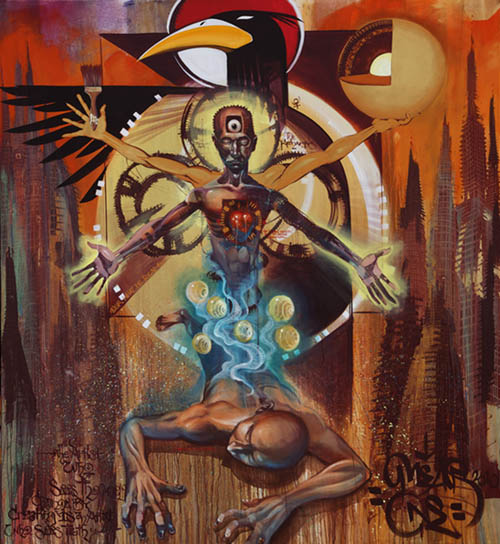
From a colored photograph that he took of an older woman's profile on the streets of LA, El Mac sprayed curved lines of black and white to form the expression and details of her face. Hanging back at a distance, observing the image, holding up his hands to his eyes to frame perspective, Mac eventually would go back to the canvas and outline the negative space, and form the depth of expression. Retna's style mixed paint using water to drip the strong lines of his calligraphy over the canvas, creating an edgy aesthetic of urban decay. Perfectly framed from left to right, he finished the collaboration with El Mac off by curving more writing along the outline of the subjects face in auburn. On day three I truly understood the masterpiece that that this duo was transforming before my eyes. The image was created as a film negative from the little color reference that El Mac had folded in his hands while he worked.
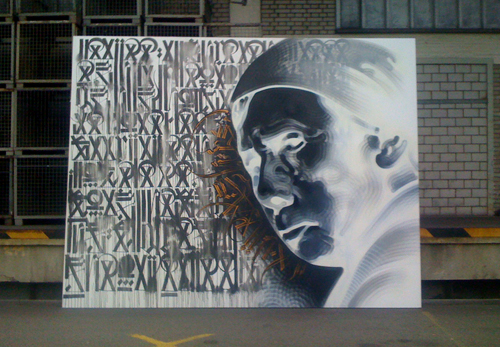
Carlos Rivera: It
was a good year for street art as it infiltrated culture from the mainstream release of the Banksy film to the affirmation of Basquiat via the retrospective at the canonical Fondation Beyeler. In simple terms, street art is a groundbreaking genre in that it has transcended the typically exclusive and opaque art world.
I left Los Angeles, as an artist seeking knowledge, as a voyeur and a participant. Four days lay before me, and I was full of expectations, having been told that going to Basel in Switzerland would be an intensive infusion into the contemporary scene, and I would leave knowing as much as or more of what's going on in this world then most. I wanted to leave some element of surprise, magic and spontaneity to my experience. I had received much hype from people who had previously attended, but I have to say that it not adequately prepare me for the overwhelming tsunami that struck me again and again in a sleepless four days in Switzerland.
Bryson Strauss:
Vox Humana directly translates as the human voice in Latin and comes from a book called 'Art & Fear' by David Bayles and Ted Orland. The final chapter of the book is called Vox Humana, and the first line of the last chapter says "to make art is to sing with the human voice". I believe that. And I think it applies beautifully to the live art experience. Like a singing voice, the moment of creation is ephemeral, even if the result remains. To me it seemed to encapsulate everything we are trying to convey in this program.
I am still singing this song and will be for some time to come.
